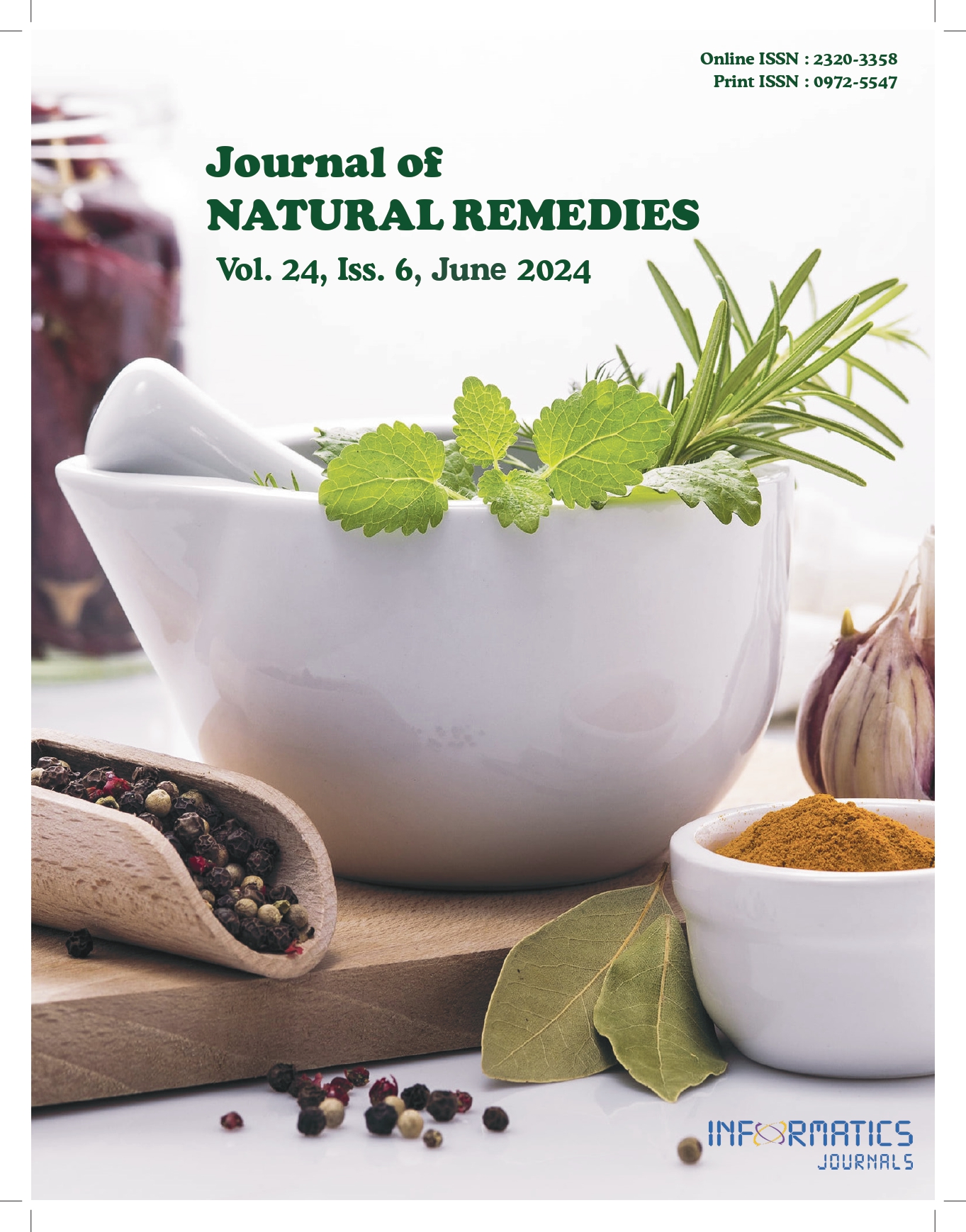Phytochemical Characterization and Evaluation of Anti-oxidant Activity of Ipomoea obscura (L.)
DOI:
https://doi.org/10.18311/jnr/2024/35891Keywords:
Antioxidant Potential, Phytochemical Analysis, LC-MSAbstract
Background: Dietary botanicals, including food additives, fruits, and vegetables, have been used for centuries as natural health remedies, but scientific evidence on their preventive properties remains limited. These dietary plants are a significant source of many natural antioxidants. Natural herbal medicines have no side effects on human health so these herbal medicines can be a safe alternative to harmful allopathic medicines. Aim: In this study, we evaluated the antioxidant potential of Ipomoea obscura leaf extract and profiled the bioactive compounds of the leaf extract. Methods: UV-visible spectroscopy, DPPH analysis, and LC-MS analysis. Results: UV-visible analysis of water, ethanol, and methanol extracts of I. obscura showed maximum absorption at 310.0 nm, 413 nm, and 337 nm. Results of DPPH analysis showed that the aqueous extract (53.80 ± 1.45, R2 = 0.92) has the maximum antioxidant potential compared to the ethanol and methanol extracts. Phytochemical analysis of the aqueous extract of I. obscura revealed several phytochemicals including alkaloids, carbohydrates, phenols, proteins, and saponins. LC-MS data confirmed the presence of 12 bioactive compounds in the aqueous extract of I. obscura leaves. Conclusion: The study reveals that the aqueous extract of I. obscura exhibits high antioxidant potential compared to ethanolic and methanolic extracts and has active secondary metabolites.
Downloads
Metrics
Downloads
Published
How to Cite
Issue
Section
Categories
License
Copyright (c) 2024 Durgesh Agase, K.S. Saini, M.S. Markam, A.S. Kale, T.S. Kothe, S. Ukey, S. Khan, S. Turkar (Author)

This work is licensed under a Creative Commons Attribution 4.0 International License.
Accepted 2024-04-24
Published 2024-06-30
References
Jakubczyk K, Dec K, Kałduńska J, Kawczuga D, Kochman J, Janda K. Reactive oxygen species - sources, functions, oxidative damage. Pol Merkur Lekarski. 2020; 48(284):124-7.
Zhang YJ, Gan RY, Li S, Zhou Y, Li AN, Xu DP, Li HB. Antioxidant phytochemicals for the prevention and treatment of chronic diseases. Molecules. 2015; 20(12):38-56. https://doi.org/10.3390/molecules201219753 PMid:26633317 PMCid: PMC6331972
Prabha P, Gopalakrishnan Velliyur Kanniappan. Phytochemical screening, functional groups, and elemental analysis of leaf extract of Ipomoea obscura (L.) Ker-Gawl. Int J Pharm and Pharm Sci. 2014; 6(1):83-85.
Daniel Geedhu, Krishna Kumari S. Quantitative analysis of primary and secondary metabolites in aqueous hot extract of Eugenia uniflora (L.) leaves. Asian J Pharm and Clin Res. 2015; 8(1):334-8.
Nagendra Prasad K, Shivamurthy GR, Aradhya SM. Ipomoea aquatica an underutilized green leafy vegetable: A review. Int J Botany. 2008; 4:123-9. https://doi.org/10.3923/ijb.2008.123.129
Vaidya BN, Brearley TA, Joshee N. Antioxidant capacity of fresh and dry leaf extracts of sixteen Scutellaria species. J. of Medic. Active Plants. 2013; 2(3):42-9.
Hamsa TP, Kuttan G. Anti-angiogenic activity of Ipomoea obscura extract and Ipobscurine. Immunopharma Immunotoxins. 2011; 33(3):488-97. https://doi.org/10.3109/08923973.2010.531277 PMid:21058930
Ruckmani DS, Chitra M, Jayamathi P. Hepatoprotective and an antioxidant study of Ipomoea hederacea on experimentally induced hepatotoxic rats. Recent Research in Science and Technology. 2010; 2(11):17-9.
Rathod MA, Mathad P. Antioxidant and anti-inflammatory activity in fresh and dry leaves of Ipomoea obscura (L.) Ker-Gawl. Int J Pharm and Bio Sci. 2018; 8(1):270-7.
Awaley MG, Nakade JG, Kale AS, Jaiswal HS. Antioxidant activity and characterization of ethanolic bark extract of Boswellia serrata. J Emer Tech and Inn Re. 2020; 7(11):102-11.
Shirwaikar A, Malini S, Kumari SC. Protective effect of Pongamia pinnata flowers against cisplatin and gentamicin-induced nephrotoxicity in rats. Ind J Experi Bio. 2003; 41(1):58-62.
Shinde P, Bhambar R, Patil P, Jadhav K, Malpure P. Exploration of phytopharmacognostical study of Ipomoea obscura (Linn.) Ker Gawl. Pharmacognosy Research. 2022; 14(4):369-78. https://doi.org/10.5530/pres.14.4.55
Ambasta SP. The useful plants of India. CSIR, New Delhi, Scientific Research Publishing. 1986. Retrieved 17 June 2023.
Chhabra SC, Viso FC, Mshiu EN. Phytochemical screening of Tanzanian medicinal plants. Int J Ethnopharm. 1984; 11(2):157-79. https://doi.org/10.1016/0378-8741(84)90037-0 PMid:6492832
Chun OK, Kim DO, Moon HY, Kang HG, Lee CY. Contribution of individual polyphenolics to the total antioxidant capacity of plums. J Agri and Food Chem. 2003; 51(25):7240-5. https://doi.org/10.1021/jf0343579 PMid:14640564
Narayana KR, Reddy MS, Chaluvadi MR, Krishna DR. Bioflavonoids classification, pharmacology, biochemical effects, and therapeutic potential. Ind J Pharmacol. 2001; 33(1):2-16.
Patil AS, Kale AS, Paikrao HM. Screening the in vitro calcium oxalate crystal inhibition potential of Abutilon indicum L. A common weed plant from the Indian medicine system. Austin J Biotech and Bioeng. 2014; 1(6):1-4.
Pham-Huy LA, He H, Pham-Huy C. Free radicals, antioxidants in disease and health. Int J Biomed Sci. 2008; 4(2):89-96. https://doi.org/10.59566/IJBS.2008.4089 PMid:23675073 PMCid: PMC3614697

 Durgesh Agase
Durgesh Agase









 0.35
0.35 24
24 0.161
0.161